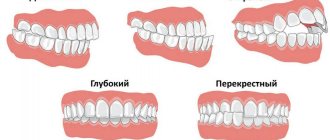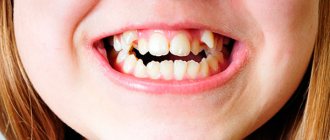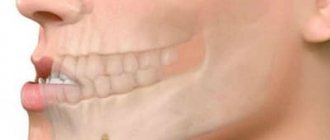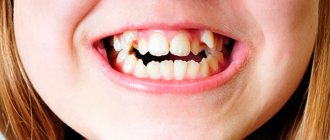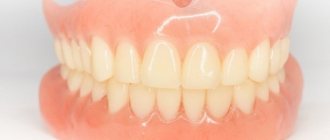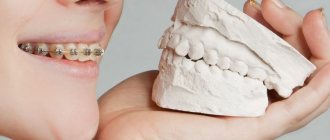Are you drafted into the army with an incorrect bite? We will help you! Malocclusion is one of the diagnoses that gives the right to a deferment or complete exemption from the army. This anomaly has several degrees of severity. They are not called up only for serious deviations, the presence of which is confirmed by medical reports. To find out whether people with an incorrect bite are accepted into the army and what fitness categories are assigned to conscripts, we advise you to study the “Schedule of Diseases”.
Article 56 is devoted to maxillofacial pathologies, where clear answers are given regarding the current restrictions.
How to determine the degree of malocclusion
This term refers to the incorrect arrangement of teeth in a closed state. The defect, in most cases acquired, often develops in the first year of the baby's life. As you get older, the situation gets worse.
The main causes of malocclusion include:
- Artificial feeding using a pacifier, sucking a pacifier.
- Incorrect head position during feeding and sleeping.
- A bad habit is thumb sucking.
- Frequent diseases of the nose - sinusitis, congestion. The child breathes through the mouth, an incorrect taste is formed, and an “adenoid” type of face develops.
- Genetic data - heredity.
In addition, one of the main reasons for the formation of malocclusion is abnormal tooth growth. If you do not respond to the problem in a timely manner, the jaw and face as a whole become distorted. In this case, braces are used to correct the bite.
Types and classification of abnormal bite:
- Mesial, medial . It can be true or false. It is determined by the advancement of the lower jaw relative to the upper. One of the most difficult anomalies, practically impossible to treat.
- Distal, prognathic . Protrusion of the upper jaw forward or a severely underdeveloped lower jaw that does not reach the upper teeth.
- Deep . A common anomaly, as a result of which there is a strong overhang of the upper jaw over the lower jaw - by 1/3 of the crown of the incisors.
- Open , disocclusion . Rarely seen. There is a noticeable gap between the teeth when the jaws close. This phenomenon causes difficulty chewing food and incorrect pronunciation of certain sounds and words. There are anterior, posterior, lateral, false, true, unilateral, bilateral, gnathic, dentoalveolar. Difficult to treat.
- Cross, scissor . It represents the intersection of the dentition in the horizontal plane. An incorrect smile and pronunciation of words are formed. There are buccal and lingual types.
The Agapov classification helps to assess the severity of the anomaly. If the closure separation is observed to be 5-9 mm, they speak of malocclusion of the 2nd degree, less than 5 mm - 1st degree, more than 9 mm - 3rd degree. The quality of chewing food is also assessed. The substrate is examined under a microscope, the percentage of grinding is calculated, and compared with normal values.
An abnormal bite can be determined visually, but a specialist must make a diagnosis and record it in the outpatient chart. In most cases, with a timely response from parents to the problem, the situation is resolved for the child. It is more difficult for an adult to correct a defect.
Stages of bite formation
The pathological type of bite is noticeable already from childhood, and its symptoms are the advancement of units forward or backward, interdental spaces, rotation of the teeth around their axis, etc.
In dental practice, there are 5 main stages of age-related development that affect the bite:
- From birth to 6 months;
- 6 months - 3 years – temporary bite is formed and milk units erupt;
- 3-6 years – stabilization of primary occlusion, active increase in jaw size and preparation for change to molars;
- 6-12 years – mixed occlusion and eruption of permanent units;
- 12-15 years – gradual formation of a constant relationship between the dentition and all permanent units.
Bite pathologies in older age are formed due to disorders that arose at one of these stages. So, some small patients push the lower jaw forward, which can distort the bite. An experienced orthodontist understands this unnatural movement at an early stage and eliminates its repetition in a playful manner.
Do they take into the army with a deep bite?
According to Article 56 of the Schedule of Diseases, a conscript has the right to be exempt from military duty in two cases:
- anomaly of 2 degrees with separation of 5-10 mm, with chewing activity less than 60%.
- anomaly of 2, 3 degrees with separation of more than 10 mm.
All other forms are conscription. The defect in grades 2 and 3 of malocclusion is visible to the naked eye. The conscript is sent for additional examination to determine the degree of chewing of food. If the anomaly can be eliminated, the young man is offered surgery. If the procedure is successfully completed, the summons will be served after 6 months. If it is impossible to eliminate the defect or the conscript refuses the operation, he is assigned fitness category “B” and released from service.
Useful video
Watch a video excerpt from the program “Live Healthy,” which talks about what malocclusion is and options for correcting it.
The current legislation provides for a number of diseases, on the basis of the presence of which, exemption from military service or a deferment from it for a certain time is provided. Such a reason, for example, could be problems with bite, depending on the degree of complexity. Such pathologies occur for various reasons: at the genetic level, teething defects or untimely contact with a specialist. Such physiological deviations can lead to a lot of inconvenience:
- difficulties in chewing food;
- disorders of the digestive process;
- premature wear of tooth enamel;
- inflammatory processes of the gums;
- dysfunction of the speech apparatus;
- deformation of the facial part of the skull;
- headache.
When passing a medical commission, it is necessary to report pathological changes by submitting copies of relevant documents confirming the fact that you contacted an orthodontist with this problem. After the necessary additional examination, the conscript may be deferred from serving or even exempted from serving. Having such dysfunctions, difficulties with chewing food are likely to occur, and in the army there is no opportunity to eat special crushed food.
Against the background of existing deviations from the norm, a specialized specialist prescribes the necessary treatment for each case individually:
- surgical intervention;
- chewing exercises;
- installation of braces.
Such treatment methods can be used either alone or in combination. If a conscript has undergone surgery, a repeat commission will be held no earlier than six months later. If the treatment outcome is positive, the young person is issued a summons. In the event that a patient refuses surgery, he will most likely be assigned a category in which he is not required to perform military service in peacetime. But are young men recruited into the army with braces installed?
Installing such a system in itself is a very expensive procedure. The structure is subject to special care on an ongoing basis, which is not always possible in the army. Regular brushing of teeth, use of dental floss and various mouth rinses, etc. - all these procedures must be performed regularly, which is very difficult, especially during field exercises, as evidenced by reviews from military personnel. An important point is periodic visits to the attending physician to monitor the process. But none of these factors gives the right to
deferment. The list of illnesses approved by law does not include an article that provides for temporary or complete exemption from service when installing a brace system. The only exceptions can be those cases when such measures are taken to correct the bite:
- 2nd degree malocclusion, with separation up to 10 mm and chewing activity up to 60%;
- malocclusion of the 2nd and 3rd degree, in which the separation is more than 10 mm.
If the structure is installed only for the purpose of aesthetically pleasing the appearance of the teeth, then such a reason will definitely not serve as a reason for exemption from military duties.
You can get a deferment if you have other diseases that “exempt” you from conscription, if any. To clarify such circumstances, it is necessary to undergo a full medical examination.
The conscript needs to clearly understand what the presence of such a structure will entail during the period of service, and whether he will be able to provide the necessary care and control over it. Very often, guys decide to remove their braces after receiving a summons. Medical workers and military commissariat employees do not have the right to force a future soldier to take such an action.
Anomaly of 2 degrees with separation of 5-10 mm
According to Art. 56 Schedules of diseases, item “b”, fitness category “B” is assigned for defects of the lower jaw, the presence of transplants after surgery. Pre-conscription conscripts upon initial registration with the military registration and enlistment office are considered to be of limited fitness - category "G" if less than 6 months have passed since the operation.
In case of malocclusion of the II degree with a separation from 5 to 10 mm with a chewing efficiency of less than 60%, in case of an malocclusion of the II, III degree with a separation of the bite of more than 10 mm (without taking into account the chewing efficiency), suitability category “B” is assigned. In case of malocclusion of the II degree with separation from 5 to 10 mm with a chewing efficiency of 60% or more percent - “B”.
For those examined with non-removed metal structures after osteosynthesis of fractures of the maxillary bone and (or) mandible with minor or no impairment of respiratory, olfactory, chewing, swallowing and speech functions, paragraph “B” applies.
If there is a malocclusion of the first degree, a displacement of the dentition by less than 5 mm, the conscript is drafted into the army.
Consequences of malocclusion
If the bite is incorrect, the food is not chewed as well as required. Food is especially poorly crushed when the bite is open.
One of the consequences of malocclusion is digestive disorders. Over time, a person experiences problems in the functioning of the gastrointestinal tract (gastrointestinal tract).
In addition, with an incorrectly distal bite, the greatest load is placed on the teeth located at the back of the mouth. They deteriorate faster and gradually wear out when the bite is deep, and from time to time the height of the bite becomes lower.
The chewing muscles, with a reduced bite, begin to constantly overstrain. Problems arise with joints: temporal and mandibular. They click, then crunch, and hurt.
What is especially unpleasant is that the nerve fibers suffer from compression and neuralgia develops. The tongue and gums are injured.
A person's overall diction and articulation may deteriorate. This may make it difficult to swallow food and liquids, and you may experience heavy breathing.
If the structure of the jaw is incorrect, the bite is deformed, the teeth do not close correctly. A dentist who performs prosthetics, seeing such problems in a patient of this category, refers him to an orthodontist.
If the dentofacial system is disturbed, then in some places it is very difficult to reliably place it in a prestigious position. When prognathism is not very pronounced, there will be no problems with prosthetics.
If you have an incorrect bite, the army is waiting for you, but you will not be able to get on a submarine or serve in the airborne forces. You are given category “b” for health, even if by other indicators you are a strong young man.
How does a military commission make a decision?
If there is an abnormal arrangement of teeth, you should seek help from a dentist. The diagnosis, the degree of chewing dysfunction, and the severity of the disease are determined by a specialist. The information is recorded in the outpatient card. You must take a photocopy of the statements with you to the commission at the military registration and enlistment office.
The commissariat examines the conscript, studies the preliminary notes of doctors, and sends him for additional examination. After re-confirmation, a fitness category is assigned. If the defect can be corrected with treatment, a deferment is given for 6-12 months, after which the conscript’s case is reconsidered.
Absolute contraindications
These are those in which correcting the bite is either impractical or impossible.
- Most of the teeth are missing.
If the chewing teeth on both sides of the upper and lower jaws have been destroyed, removed or missing, then it often makes no sense to correct the position of the remaining ones. When preparing for prosthetics, the doctor will most likely offer an alternative option.
If you have only a few teeth, braces cannot be installed.
- Dystrophic processes in the jaw bone, periodontal disease.
Bone atrophy or thinning are synonymous. The essence of the process is that bone tissue cells are not renewed, the volume of the bone gradually decreases, the roots of the teeth begin to stay in it worse and can become loose. This process requires supervision by a dentist or periodontist, since with due attention to your health, you can slow down the development of the disease and save your teeth. But treatment by an orthodontist, which is accompanied by a strong impact on the roots of the teeth, is no longer carried out.
It is possible to correct a bite if the tissue of the jaw bone is dense and holds the roots of the teeth well.
- Several implants.
Even one implant puts the possibility of correcting the bite into question, since usually when wearing braces or aligners, all teeth move to one degree or another. And if there are several implants, it is impossible to avoid pressure on them. Unlike tooth roots, implants are not able to withstand such a load.
The generally accepted procedure is: first treatment with an orthodontist, and only then installation of implants.
Will they be accepted into the army with braces in 2022?
Professional installation of braces is an expensive procedure that requires constant supervision by specialists and special dental care. Special food is provided. In the army, all these conditions cannot be met. However, according to the Schedule of Diseases, exemption from the army with fitness category “B” is not allowed. The exception is surgery to correct a grade 2 malocclusion with a separation of more than 5 mm.
In some cases, the military commissariat meets the conscript halfway, gives him time to complete his treatment, assigns category “G”, after which a re-examination is scheduled. If a young man has braces, he should consider removing them before going into the army, since it will not be possible to provide full care for the oral jaw.
Who is considered fit for service?
According to the degree of health suitability for military service, there are categories:
- "A".
- "B".
- "IN".
- "G".
- "D".
What category you have will be determined by the military medical commission when you undergo a medical examination. Group “B” is called up, but group “C” is not. Some fairly healthy young people want to break the law and want to be assigned category “B” and released from service.
Before passing a special medical examination, it is best for you to visit doctors and ask how healthy you are, are you subject to compulsory conscription or not? All categories except the last “D” are subject to change.
For example, at the time of conscription your arm was broken and you received category “G”. After 2 months the bones will heal during a second medical examination after 6 months. and moreover, you feel great. You may be given category “A” or “B” and taken to serve in the army.
Categories
Let's take a closer look at the categories:
- "A" is good health. Fit for military service.
- “B” health is normal, but there are some limitations. Detected deficiencies do not prevent you from serving. For example, myopia is slight.
If you have category “B”, then it is customary to specify: “B-1” or “B-2”, which means “B-3”, etc. 1, the most that the restrictions are less than with 3. Conscript with “B” will not be hired to serve in the navy or as a paratrooper. They recruit strong young men there.
- Your “B” is fit for service, but with restrictions. In fact, experts believe that he is not fit to have serious health problems. You will not be drafted, but will be enlisted honorably in the reserve.
- “G”, it is believed that the young man is currently (temporarily) serious about serving, and later, when he recovers, for example, from an injury of varying severity, the military registration and enlistment office will send him a summons. There will be a chance in 6 months. or 1 year to enter the service.
- “D” Thus, he is definitely unfit to serve. There will be no re-examination.
Reviews
Dear readers, you can leave your feedback on whether people with an incorrect bite are accepted into the army in the comments, your opinion will be useful to other users of the site!
Andrey
“Theoretically, we can do everything, practically nothing. You still need to be able to prove an incorrect bite. They are sent to the army with major defects.”
Oleg
“I got braces shortly before the commission at the military registration and enlistment office, I thought it would help me get a deferment. No, they said, take it off and go ahead and serve.”
